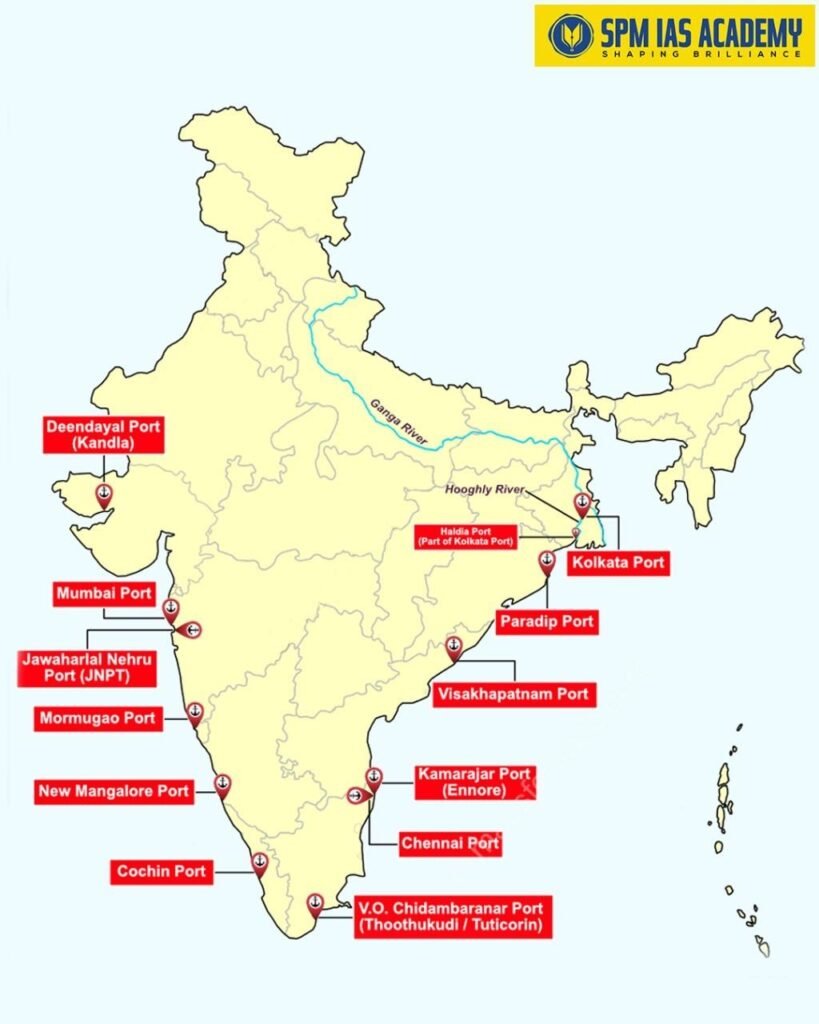Recently, the Prime Minister of India said, “2026 will be ASEAN-India year of maritime cooperation.” In this regard, the major ports in India will play a pivotal role by strengthening trade connectivity, enhancing blue economy initiatives and promoting sustainable maritime partnerships across the Indo-Pacific region.
India, with its vast coastline of over 11,099 km, has played a crucial role in maritime trade since ancient times. From the Indus Valley civilization’s Lothal Port to modern shipping hubs, India’s ports have been vital to its economic growth, trade, and defense.
Understanding the major ports in India, along with their distribution on the western and eastern coasts, is crucial for every UPSC, APSC, and State PCS aspirant, as it forms an integral part of Indian Geography and Infrastructure topics.
What Are Major Ports in India?
Before moving ahead, let’s define what major ports are.
- Major ports are ports owned and managed by the Central Government of India, under the Ministry of Ports, Shipping and Waterways.
- They handle the majority of India’s international maritime trade and are equipped with advanced infrastructure, container terminals, and navigation facilities.
- In contrast, minor and intermediate ports are managed by State Governments.
- There are 14 major ports out of which 12 Major Ports are in Operation and 200 non-major ports (minor ports) in the country.
- While the Major Ports are under the administrative control of Ministry of Ports, Shipping and Waterways, the non-major ports are under the jurisdiction of respective State Government.
- Out of the 200 non-major ports, around 65 ports are handling cargo.
- While, the others are “Port Limits” where no cargo is handled and these are used by fishing vessels and by small ferries to carry passengers.
List of Major Ports in India:

List of Major Ports in India:
| Sl No. | Name of Port | Location (State) | Coast |
| 1 | Kandla (Deendayal Port) | Gujarat | Western Coast |
| 2 | Mumbai Port | Maharashtra | Western Coast |
| 3 | Jawaharlal Nehru Port (Nhava Sheva) | Maharashtra | Western Coast |
| 4 | Mormugao Port | Goa | Western Coast |
| 5 | New Mangalore Port | Karnataka | Western Coast |
| 6 | Cochin (Kochi) Port | Kerala | Western Coast |
| 7 | Tuticorin (V.O. Chidambaranar Port) | Tamil Nadu | Eastern Coast |
| 8 | Chennai Port | Tamil Nadu | Eastern Coast |
| 9 | Ennore (Kamarajar Port) | Tamil Nadu | Eastern Coast |
| 10 | Visakhapatnam Port | Andhra Pradesh | Eastern Coast |
| 11 | Paradip Port | Odisha | Eastern Coast |
| 12 | Kolkata Port (Syama Prasad Mookerjee Port) | West Bengal | Eastern Coast |
| 13 | Vadhavan Port (under construction) | Maharashtra | Western Coast |
Ports on the Western Coast of India:
- The Western Coast of India lies along the Arabian Sea, stretching from Gujarat to Kerala.
- It features natural harbours and deep-water ports, making it ideal for handling large cargo ships.
1. Kandla Port (Deendayal Port) – Gujarat
- Established in 1955 after India’s partition to handle trade lost to Karachi Port.
- One of India’s largest and busiest ports by cargo volume.
- Handles petroleum, fertilizers, and food grains.
- It was renamed as Deendayal Port in 2017 under Indian Ports Acts, 1908.
- It is in a strategic location – Kandla Creek, 90 km from the Gulf of Kutch.
- This major port will enhance trade through key corridor like India- Middle East Europe Economic Corridor and International North-South Transportation Corridor.
2. Mumbai Port – Maharashtra
- The oldest port in India, with a natural harbour.
- Handles liquid chemicals, iron, steel, and textiles.
3. Jawaharlal Nehru Port (Nhava Sheva) – Maharashtra
- India’s largest container port, handling over 50% of India’s containerized cargo.
- Named after India’s first Prime Minister, Jawaharlal Nehru.
4. Mormugao Port – Goa
- Established in 1885 in Goa, it plays crucial role in iron ore export.
- Plays a major role in Goa’s economy and maritime trade.
- In 1964, it got the designation of major port.
5. New Mangalore Port – Karnataka
- Established in 1975, it is a major all-weather port in Panambur, Mangalore, Karnataka.
- It handles crude oil, fertilizers, and coal.
- It acts as the gateway for Karnataka’s industrial regions.
6. Cochin (Kochi) Port – Kerala
- Its history dates back to 1341 AD when a flood from the Periyar river created a navigable harbour.
- A natural harbour connecting trade routes with the Middle East, it features India’s largest International Container Transhipment Terminal (ICTT).
- Handles petroleum, fertilizers, and spices.
Ports on the Eastern Coast of India:
1. Kolkata (Syama Prasad Mookerjee Port) – West Bengal
- Located on the Hugli River, it is India’s oldest operating port and only major riverine port in the country.
- The port comprises two main dock systems-
- Kolkata Dock System
- Haldia Dock Complex
- It exports jute, textile, and tea and import coal, fertilisers and machinery.
2. Paradip Port – Odisha
- It is a key deep-water port in Odisha.
- The first major port on India’s east coast, established after independence. It became operational in 1966 as India’s eight major port.
- It exports iron ore, thermal coal and finished steel and imports crude oil, petroleum products and fertilisers.
3. Visakhapatnam Port – Andhra Pradesh
- Established in early 20th century, it is India’s deepest port.
- Deals with iron ore, petroleum, and fertilizers.
- Serves as a naval base for the Eastern Naval Command.
- In 2024, it surpassed its earlier record of cargo handling.
- This major port enhances India’s influence in the Indian Ocean region, connecting to Southeast Asia and Central Asia.
4. Chennai Port – Tamil Nadu
- Established in 1881, it is the second largest container port in India.
- This port will enhance trade between India and Russia under the Chennai-Vladivostok Maritime Corridor (CVMC).
- It is one of the oldest artificial ports in India.
- Handles automobiles, containers, and general cargo and crude oil, metals and machineries.
5. Ennore Port (Kamarajar Port) – Tamil Nadu
- India’s first corporate port.
- Established in 2001, to support thermal coal transport for the Tamil Nadu Electricity Board.
- It operates under Kamarajar Port Limited.
- Specializes in handling coal and automobiles. It imports key commodities like thermal coal, crude oil, LNG, fertilisers and bulk goods.
6. Tuticorin (V.O. Chidambaranar Port) – Tamil Nadu
- It got the designation of major port on July 11, 1974. It is the second largest port in Tamil Nadu and the third largest container terminal in India.
- The port honours the legacy of V.O. Chidambaram Pillai, a renowned freedom fighter and maritime pioneer.
- Plays a key role in India’s southern maritime trade.
Important Minor Ports of India:
- The minor ports supports regional trade, fishing, and passenger transport along India’s 11,099 km-long coastline.
- Out of the total, nearly 65 minor ports actively handle cargo operations, while others primarily cater to fishing and ferry services.
- Some of the important minor ports of India include:
- Azhikkal Port (Kerala)
- Belekeri Port (Karnataka)
- Kannur Port (Kerala)
- Kundapur Port (Karnataka)
- Dahej Port (Gujarat)
- Jafrabad Port (Gujarat)
- Jakhau Port (Gujarat)
- Kasargod Port (Kerala)
- Neendakara Port (Kerala)
- Pindhara Port (Gujarat)
- Ponnani Port (Kerala)
- Tellicherry/Thalassery Port (Kerala)
- Beypore Port (Kerala)
- Port Blair (Andaman & Nicobar Islands)
Significance of Major Ports of India
- These ports handle 95% of foreign trade by volume and 70% by value. They also managed 795 million tonnes of cargo (2022–23).
- Ports like Mumbai and Chennai are crucial for trade with Iran, Russia, and beyond. They connect Asia, Europe and Africa through global shipping routes.
- Some of them are historically important. Ports such as Kolkata (est. 1870) served as ancient trade gateways, fostering cultural and commercial exchanges with Southeast Asia and Europe.
- Infrastructure Growth: Under the Sagarmala Project, cargo capacity rose 87% (2014–15 to 2023–24), reflecting strong port modernization and expansion.
- To promote green technology, Ports are adopting electric vehicles, digital systems, and green practices to reduce their environmental footprint.
Conclusion:
To sum up, India’s major ports along the Western and Eastern coasts form the backbone of its maritime economy. While western coast ports like Mumbai, Kandla, and Cochin lead in cargo handling, eastern coast ports such as Visakhapatnam, Paradip, and Chennai connect India to Southeast Asia and global trade routes.
For every UPSC, APSC, or State PCS aspirant, understanding these ports not only strengthen their knowledge on Indian Geography but also provides insight into India’s strategic economic and defence outlook.
Sources:
Latest Articles
| Article Title | Read More |
|---|---|
| Top 10 UNESCO World Heritage Sites in India | Read Article |
| Special Agencies of United Nations | Read Article |
| Tiger Reserves in India | Read Article |
| Neighboring Countries of India | Read Article |
| Middle East Countries | Read Article |
| Top 10 Highest Mountain Peaks in India | Read Article |
| 10 Most Powerful Countries in the World by Military Strength | Read Article |
There are 14 major ports in India, out of which 12 are operational. While Port Blair has been removed from the list, the Vadhavan Port in Maharashtra is under construction.
Major ports are managed by the Central Government under the Ministry of Ports, Shipping and Waterways, while minor ports are managed by State Governments.
Major ports on the western coast include Kandla (Deendayal), Mumbai, Mormugao, New Mangalore, and Cochin.
Major ports in India handle about 95% of foreign trade by volume, serving as key hubs for export-import, economic growth, and maritime connectivity.
Major ports on the eastern coast include Kolkata (Syama Prasad Mookerjee), Paradip, Visakhapatnam, Chennai, Ennore (Kamarajar), and Tuticorin (V.O. Chidambaranar).












